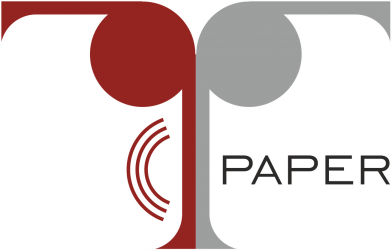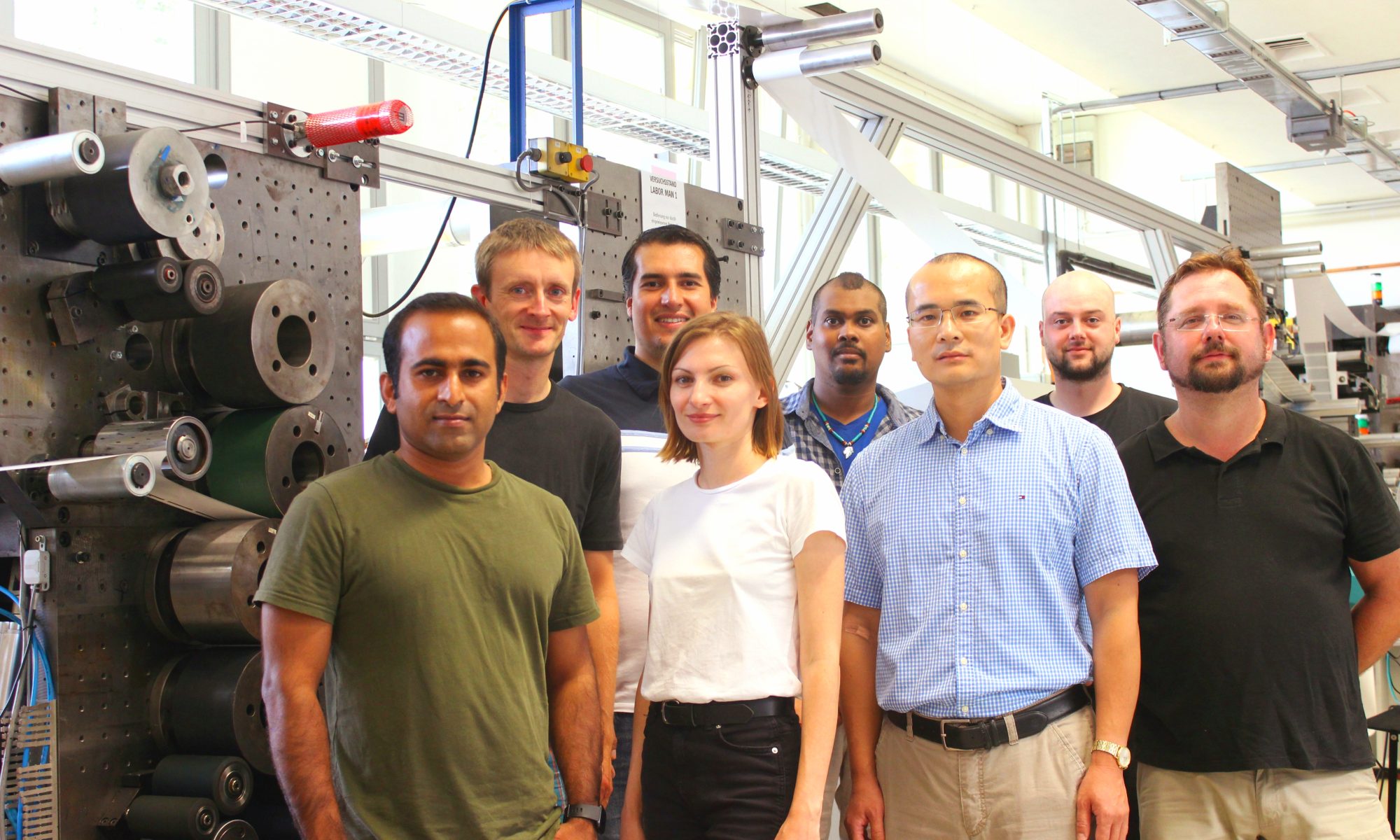In the TUCscicast Dr. Georg Schmidt responds the questions about the latest developments of T-PAPER technology, advantages of the printed electronics today as well as the ideas for the future applications on the basis of printed paper lodspeakers. You will find the TUCscicast in every podcast app!
New T-PAPER video by TU Chemnitz
Finally we can present our T-RING prototype!
In the new T-PAPER video you can see one of the final applications which could be realized with paper-based piezoelectric loudspeakers. A 360° surround-sound installation can be used in exhibition booth as well as for acoustic accompaniment of museum exhibits.
Japanese delegation visited pmTUC
On September 25, the delegation from the Yamagata University visited the Institute for Print and Media Technology. Thanks to support by Organic Electronics Saxony was able to construct connection with colleagues in the field of flexible electronics. Among participants we could also meet the representatives of some Japanese companies. The T-PAPER team talked about Printed Piezoelectric Polymer Loudspeakers. In conclusion the participants had an opportunity to get a view of the laboratories of pmTUC.
The visit allowed the members of the delegation to gain a more comprehensive understanding of the printed piezoelectric polymer loudspeakers and of printed electronics in general.

New scientific paper published
The T-PAPER team published their latest study of “Fully Printed Piezoelectric Polymer Loudspeakers with Enhanced Acoustic Performance” in Advanced Engineering Materials. Xunlin Qiu, Georg C. Schmidt, Pramul Muraleedhara Panicker, Ricardo Alonso Quintana Soler, Aravindan Joseph Benjamin and Arved C. Hübler investigated the influence of remanent polarization and the area of the piezoelectrically active layer on the acoustic output of the loudspeakers. Dielectric spectroscopy was used to study the dielectric properties of the printed loudspeakers before and after poling. Due to the remanent polarization the T-PAPER team could realize a much higher sound pressure level than that achieved by previous tests.
Moreover, this work provides a better comprehension of functionality of fully printed piezoelectric polymer loudspeakers.
VIP+ Report of the Federal Ministry of Education and Research
The Federal Ministry of Education and Research published a report on the last VIP+ Innovation Conference 2019 in Berlin. The T-PAPER team also participated in the Conference 2019. Their printed loudspeaker was presented at the exhibition VIP+UP! .
The aim of the Innovation Conference is a technology transfer from universities to industry. The grant-aided projects have an opportunity to exchange their experiences and to present their latest developments.
The T-PAPER project is funded under VIP+ program by the Ministry of Education and Research since 2017.
T-PAPER presented at the IEEE ISE 2019 in Ireland
The T-PAPER project participated in the 17th International Symposium on Electrets at the University of Limerick.
Dr. Xunlin Qiu talked about “Fully printed polymer layer structures as flexible piezoelectric loudspeaker” and took part in some workshops. He also got a chance to talk about the latest developments of the T-PAPER project with colleagues from Malaysia, Japan, the United Kingdom, China, Denmark and Austria.
Furthermore, the IEEE 17th International Symposium on Electrets was a great opportunity to meet some industrial representatives, such as Bosch Group and Altratech.
T-PAPER put their heads together about remaining months of the project
T-PAPER had a team meeting to discuss successful last months and to brainstorm about new applications of a T-Paper.
Dr. Georg Schmidt gave update and set new proposals for the next months of the project. All this time we were advancing our technology and moving closer to our final goal! We also welcomed a new team member. Varvara Bachul is responsible for marketing and costing. She will also support the T-PAPER project during commercialization.
Our team consists of researchers from all over the world: Sri-Lanka, Colombia, China, India, Russia and Germany. So we are full of energy and looking forward to the next successful months!
T-PAPER at ISE 2019 – 17th International Symposium on Electrets in Ireland
The T-PAPER project goes to the University of Limerick in September.
Dr. Xunlin Qiu will present the latest developments of our technology to the scientific community and manufacturing industry. He will also talk about our T-Box. The IEEE ISE 2019 event includes international guest speakers, workshops and exhibitions. The symposium in Limerick is also an ideal meeting ground for industry to hear from researchers on their latest innovations and practical applications.
Auf dem Weg zum klingenden Fotobuch
PRESSEMITTEILUNG
Institut für Print- und Medientechnik der TU Chemnitz will mit dem Druck von Papier-Lautsprechern den Massenmarkt erreichen – Bund fördert das Projekt mit rund 1,4 Millionen Euro
Die Lautsprecher der Zukunft werden, wenn es nach dem Institut für Print- und Medientechnik der Technischen Universität Chemnitz geht, dünn wie Papier sein und Verpackungen und Fotobücher zum Klingen bringen. In den Labors der Chemnitzer Forscherinnen und Forscher ist dies nahezu Realität, denn sie entwickelten bereits 2015 das mehrfach ausgezeichnete „T-Book“ – einen großformatigen Bildband, der mit gedruckter Elektronik ausgestattet ist. Blättert man eine Seite um, dann beginnt diese durch einen unsichtbar im Inneren des Blatt Papiers befindlichen Lautsprecher zu tönen. „Das T-Book war und ist ein Meilenstein in der Entwicklung gedruckter Elektronik“, meint Prof. Dr. Arved C. Hübler, unter dessen Leitung dieser Technologietrend bereits seit 17 Jahren vorangetrieben wird und weltweit zunehmend Beachtung findet.
Die klangvolle Innovation aus Chemnitz wird bisher in einer halbautomatischen Einzelbogenfertigung hergestellt. Dabei werden ganz normales Papier oder Folien mit zwei Schichten eines leitfähigen organischen Polymers als Elektroden bedruckt. Dazwischen kommt eine piezoelektrische Schicht als aktives Element, was das Papier oder die Folie in Schwingungen versetzt. Laut und deutlich wird durch die Luftverdrängung der Sound erzeugt. Die beiden Seiten des Lautsprecherpapiers lassen sich farbig bedrucken. Da dies aktuell nur in einzelnen Bögen möglich ist, ist die Effizienz des Verfahrens sehr gering.
Deshalb gehen die Forscher des Instituts für Print- und Medientechnik seit Mai 2017 einen neuen Weg – hin zur kostengünstigen Massenproduktion. Ziel ihres aktuellen Projektes „Rollengedrucktes Lautsprecherpapier“ (kurz: T-Paper) ist es, die aktuelle Bogenherstellung in eine Rollenfertigung zu überführen. „Damit soll die Effizienz des gesamten Herstellungsprozesses erheblich gesteigert werden, um zukünftig beispielsweise Massenmärkte wie Fotobücher adressieren zu können“, berichtet Projektleiter Georg C. Schmidt. Zudem sei geplant, die Leistungsfähigkeit und die Anmutung des Lautsprecherpapiers zu optimieren. „Somit wird die Möglichkeit eröffnet, das Potenzial des Lautsprecherpapiers voll auszunutzen und auch auf weitere Anwendungsbereiche – zum Beispiel im Bereich der Sensorik – auszuweiten“, so Schmidt.
Das Projekt „T-Paper“ wird im Rahmen der Fördermaßnahme „Validierung des technologischen und gesellschaftlichen Innovationspotenzials wissenschaftlicher Forschung – VIP+“ vom Bundesministerium für Bildung und Forschung in den kommenden drei Jahren mit rund 1,4 Millionen Euro gefördert.
von Mario Steinebach, TU Chemnitz
Foto: TU Chemnitz/Uwe Meinhold






